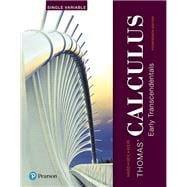About This Book
Thomas' Calculus: Early Transcendentals, Single Variable
ISBN: 9780134439419
About This Book
Thomas' Calculus: Early Transcendentals, Single Variable is a comprehensive textbook designed for the single-variable component of three-semester or four-quarter calculus courses. It's a go-to resource for students and educators alike, offering a detailed exploration of calculus principles and meeting scope and sequence requirements for typical introductory calculus courses.
Who Uses It?
Primarily, this book is used by students and instructors in introductory calculus courses at the college and university levels. It's also a valuable resource for anyone interested in understanding the basics of calculus, including professionals looking to refresh their knowledge or expand their understanding of mathematical principles.
History and Editions
The 14th edition of Thomas' Calculus: Early Transcendentals has been updated to address user feedback, incorporating the latest research and applications in calculus. This edition includes detailed updates on mathematical clarity and accuracy, ensuring that it remains current and relevant. The text balances clear and intuitive explanations with current applications and generalized concepts, helping students generalize key concepts and develop a deeper understanding of calculus.
Author and Other Works
Joel R. Hass, Maurice D. Weir, and Christopher E. Heil are the authors of Thomas' Calculus: Early Transcendentals. Joel Hass is known for his ability to explain complex mathematical concepts clearly and simply. Maurice Weir brings his expertise in calculus to the text, ensuring that it remains current and relevant. Christopher Heil, a new co-author in the 14th edition, partners with Joel Hass to preserve what is best about Thomas' time-tested text while reconsidering every word and piece of art with students in mind.
Key Features
- Comprehensive Coverage: The book covers core concepts in single-variable calculus, including detailed explanations and examples.
- Interactive Digital Learning Experience: The text offers an interactive digital learning experience with instant feedback on assignments and study tools.
- Supportive Learning Tools: The book provides help when and where you need it, making it easier for students to understand and apply calculus concepts.
- Detailed Explanations: The text includes clear and intuitive explanations, current applications, and generalized concepts to help students generalize key concepts and develop a deeper understanding of calculus.
Detailed Information
ISBNs and Formats
- 9780134439419: Hardcover
- 9780137399185: Interactive digital learning experience (14th edition)
Publication Details
- Publisher: Pearson Education
- Publication Date: January 1, 2017
- Number of Pages: Varies by edition
- Language: English
Other Editions and Formats
- 9780137399185: Interactive digital learning experience (14th edition)
- 9780134439419: Hardcover (14th edition)
- 9780134439414: Paperback (14th edition)
Related ISBNs:
- 9780137399185: Interactive digital learning experience (14th edition)
- 9780134439414: Paperback (14th edition)
- 9780134439419: Hardcover (14th edition)
This detailed information section provides a quick reference for all the available formats and sources for Thomas' Calculus: Early Transcendentals, Single Variable, making it easier to find and access the book in the preferred format.









